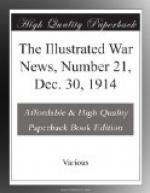This drawing by a German artist shows General Liborius von Frank (riding in front of the standard-bearer) entering Belgrade at the head of the Fifth Austrian Army on December 2. As the troops passed the Konak, the building in the background with a cupola, they sang the Austrian national anthem. General Frank sent the following message to the Emperor Francis Joseph: “On the occasion of the sixty-sixth anniversary of your Majesty’s accession permit me to lay at your feet the information that Belgrade was to-day occupied by the troops of the Fifth Army.” Belgrade remained in Austrian hands less than a fortnight. The Serbians recaptured it after a desperate battle. At Belgrade they placed 60,000 Austrians hors de combat, and from December 3 to 15 had captured 274 officers and 46,000 men.
_______________________________________________________
___________________ 18—THE ILLUSTRATED WAR NEWS, DEC. 30, 1914.—[Part 21]
[Illustration: A GERMAN DREAM OF EMPIRE ENDS IN SMOKE: TSING-TAU SET ON FIRE BY SHELLS FROM JAPANESE HEAVY ARTILLERY.]
This impressive photograph was taken during the bombardment of Tsing-tau, Germany’s cherished possession in the Far East, which fell to the Japanese and British arms on November 7. In the distance the smoke of her burning is seen going up to heaven. The blockade of Tsing-tau began on August 27. The Japanese troops landed in Lao-shan Bay on September 18, the small British force on the 24th. On the 28th they carried the high ground 2-1/2 miles from the main German position, and fire was opened on the fortress during the first week in October. The general bombardment began on October 31 and lasted till the night of November 6, when the Japanese stormed the central fort. We illustrate on another page one of the Japanese heavy siege-guns used at Tsing-tau.—[Photo. by Record Press.]
_______________________________________________________
___________________ THE ILLUSTRATED WAR NEWS, DEC. 30, 1914—[Part 21]—19
[Illustration: IN THE BATTERIES AGAINST TSING-TAU: A JAPANESE SIEGE-GUN GETTING THE ORDER BY TELEPHONE TO OPEN FIRE.]
We see here one of the heavy siege-guns which the Japanese brought up for the bombardment of Tsing-tau when about to open fire on the German fortress. The gun-team of artillerymen are standing in rear of the piece, and in the foreground, to the right, is one of the detachment receiving orders by telephone from the battery-commandant at his post of observation. Profiting by their experiences in siege-warfare at Port Arthur, the Japanese were fully prepared with a very large and efficient siege-gun train to undertake the attack on Tsing-tau immediately war was declared. The Japanese employed 140 guns in the bombardment, including 28-centimetre howitzers and 21 and 15 cm. siege-guns, firing respectively, 11.2-inch, 8.4-inch, and 6-inch shells.—[Photo. by Record Press.]




